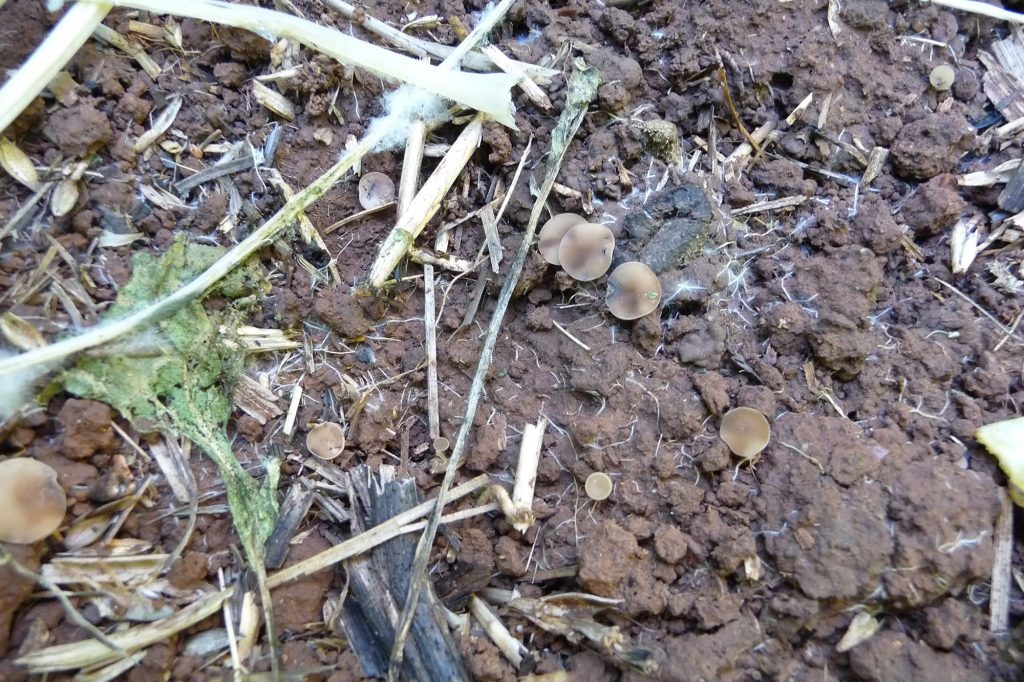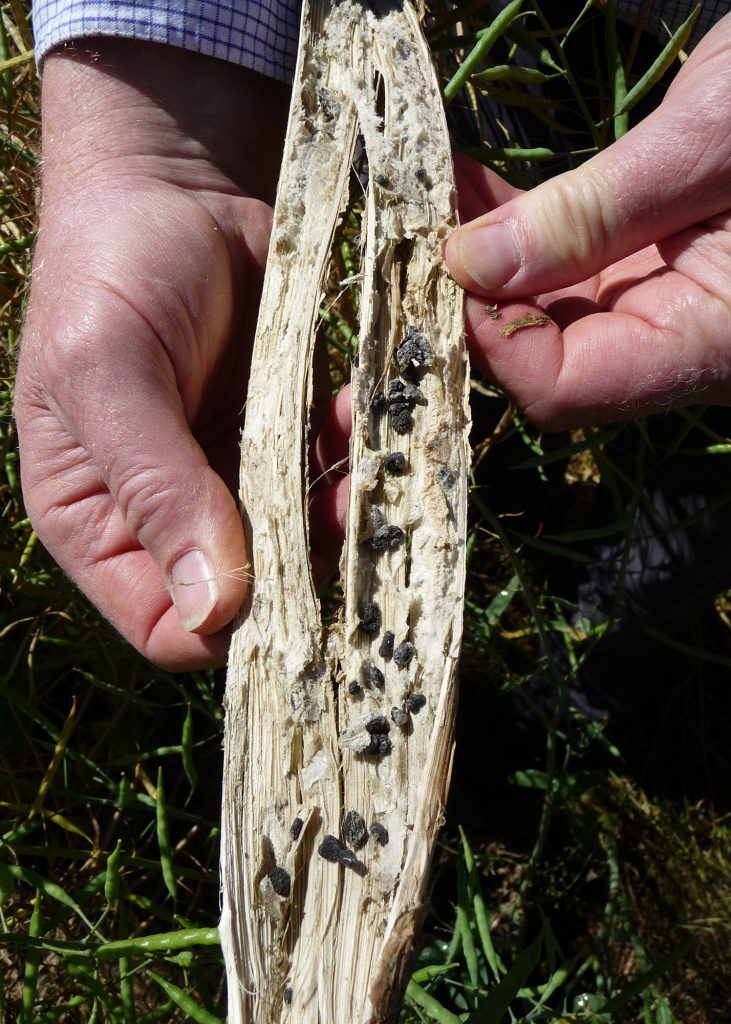Wet winter conditions have favoured the establishment of Sclerotinia stem rot in many southern farming districts
Sclerotinia stem rot is caused by the fungal pathogen Sclerotinia sclerotiorum. This fungus can infect over 300 plant species, mostly broadleaf plants, including many crop, pasture and weed species, including canola, lupins, chickpea, sunflower and lucerne.
Levels of Sclerotinia stem rot have been increasing in recent years, particularly in southern NSW, with increases in canola plantings and wheat-canola rotations.
Wet winter conditions in 2016 so far have been favourable for the disease to become established in many districts in the southern region.
How does Sclerotinia stem rot develop?
The disease cycle of Sclerotinia stem rot is complex compared with other plant diseases, which is why the disease tends to be sporadic in appearance between years and districts.
For stem rot symptoms to develop a sequence of events has to occur:
Conditioning of the sclerotia in the soil
Sclerotia are hard, black bodies that resemble rat droppings and are the resting stage of the fungus. They germinate in the soil to produce airborne fungal spores, which are released from small golf tee-shaped structures (5–10 mm in diameter) known as apothecia. For this to occur prolonged moist soil conditions are required. Soils have to be virtually saturated for 10-14 days for sclerotia to soften and germinate. Most sclerotia will remain viable and capable of producing apothecia for up to 3–4 years before survival slowly declines.
Colonisation of petals or neighbouring canola
Spores of the Sclerotinia pathogen cannot infect canola leaves and stems directly. They require petals as a food source for spores to germinate and to colonise. When the infected petal eventually falls, it may become lodged onto a leaf, within a leaf axil or at branch junctions along the stem. If conditions are moist the fungus grows out of the petal and invades healthy plant tissue (either a leaf or stem), resulting in a stem lesion and production of further sclerotia within the stem, which will then be returned to the soil after harvest.
Sclerotia also have the ability to germinate in the soil, and produce branching, thread-like structures called mycelium, which directly infect canola plants in close proximity causing a basal stem infection.


Adequate moisture in the crop canopy
Weather conditions during flowering play a major role in determining the development of the disease. The presence of moisture during flowering and petal fall will determine if Sclerotinia stem rot develops. Dry conditions during this time can quickly prevent development of the disease, hence even if flower petals are infected, dry conditions during petal fall will prevent stem infection development.
Symptoms of Sclerotinia stem rot
Symptoms of stem rot generally first appear in the crop 2-3 weeks after initial infection. However, it will take a further 2-3 weeks for dead plants and branches to appear within the crop.
At first lesions may appear on leaves before the stem rot develops. This is the consequence of infected petals falling onto lower leaves and leaf junctions when the crop canopy has adequate moisture. Leaf lesions are grey and will develop and spread from under a fallen petal.
Stem lesions first appear as discreet light brown discoloured patches on plant stems and branches, often originating at a leaf or stem junction. These lesions expand; take on a greyish white colour, giving the plant a bleached appearance. At first stem lesions develop on one side of the stem, but will expand with time to completely girdle the stem, resulting in premature death above the lesion.
Infected canola plants ripen earlier and stand out as bleached or greyish-coloured plants among green, healthy plants. The bleached stems tend to break and shred at the base.
When an infected canola stem is split open, sclerotia can usually be found inside. In wet or humid weather, a white fungal growth that resembles cotton wool (mycelium) can also develop on the infected stems and sclerotia may develop in this white growth on the outside of the stem.


Predicting an outbreak
- Spring rainfall – Epidemics of Sclerotinia stem rot generally occur in districts with reliable spring rainfall and long flowering periods for canola.
- Frequency of Sclerotinia outbreaks – Use the past frequency of Sclerotinia stem rot outbreaks in the district as a guide to the likelihood of futureoutbreaks. Paddocks with a recent history of Sclerotinia are a good indicator of potential risk, as well as paddocks that are adjacent. Consider the frequency of canola in the paddock. Canola is a very good host for the disease and can quickly build up levels of soil-borne sclerotia.
- Commencement of flowering – The commencement of flowering can determine the severity of a Sclerotinia outbreak. Spore release, petal infection and stem infection have a better chance of occurring when conditions are wet for extended periods, especially for more than 48 hours. Canola crops that flower earlier in winter, when conditions are cooler and wetter, are more prone to disease development.
Managing Sclerotinia stem rot
Epidemics of Sclerotinia stem rot generally occur in districts with reliable spring rainfall and long flowering periods for canola. Paddocks with a recent history of Sclerotinia are a good indicator of potential risk, as well as those paddocks that are adjacent. There are important cultural management options to consider before the use of tactical fungicide treatments:
- Sowing canola seed that is free of sclerotia. This applies to growers retaining seed on farm for sowing. Consider grading seed to remove sclerotia that would otherwise be sown with the seed and infect this season’s crop.
- Separate this season’s canola crop away from last year’s canola stubbles. This not only works for Sclerotinia, but other diseases such as blackleg.
- Rotate canola crops. Continual wheat-canola rotations are excellent for building up levels of viable sclerotia in the soil. A 12-month break from canola is not effective at reducing sclerotia survival. Consider other low risk crops such as cereals, field pea or faba bean.
- Follow recommended sowing dates and rates for your district. Canola crops that flower early, with a bulky crop canopy are more prone to developing sclerotinia stem rot. Bulky crop canopies retain moisture and increase the likelihood of infection. Wider row spacings can also help by increasing airflow through the canopy to some degree until the canopy closes.
If the situation warrants it, consider the use of a foliar fungicide. Weigh up yield potential, disease risk and costs of fungicide application when deciding to apply a foliar fungicide.
Use of foliar fungicides
The opportunity to apply foliar fungicides to manage the disease is approaching. Ideal timing for foliar fungicides commences at the 20 – 30% bloom stage (15 – 20 open flowers off the main stem). At this stage a foliar fungicide application will target early flowers, but also allow penetration of the fungicide into the crop canopy where infected petals are likely to become lodged.
Bloom is defined as the number of flowers on each plant, not the number of flowering plants within the crop.
The main aim of a foliar fungicide application at this crop growth stage is to protect the primary stem from early infection, which will cause the most yield loss.
Foliar fungicides applied to manage Sclerotinia stem rot will provide approximately 3 weeks of protection, so a single fungicide application may not prevent some later infections developing.
As crops commence flowering monitor weather events closely. Foliar fungicides are best applied before an infection event. Currently registered fungicides to manage Sclerotinia include Prosaro® and various fungicides containing iprodione or procymidone.
Contacts
Dr. Kurt Lindbeck, Plant Pathologist, NSW DPI, Wagga Wagga kurt.lindbeck@dpi.nsw.gov.au
Audrey Leo, Plant Pathologist, NSW DPI, Wagga Wagga audrey.leo@dpi.nsw.gov.au
Acknowledgements
The PestFacts south-eastern team thanks guest authors Dr Kurt Lindbeck and Audrey Leo (NSW DPI Wagga Wagga) for preparing this article.
Cover image: Photo by Kurt Lindbeck





